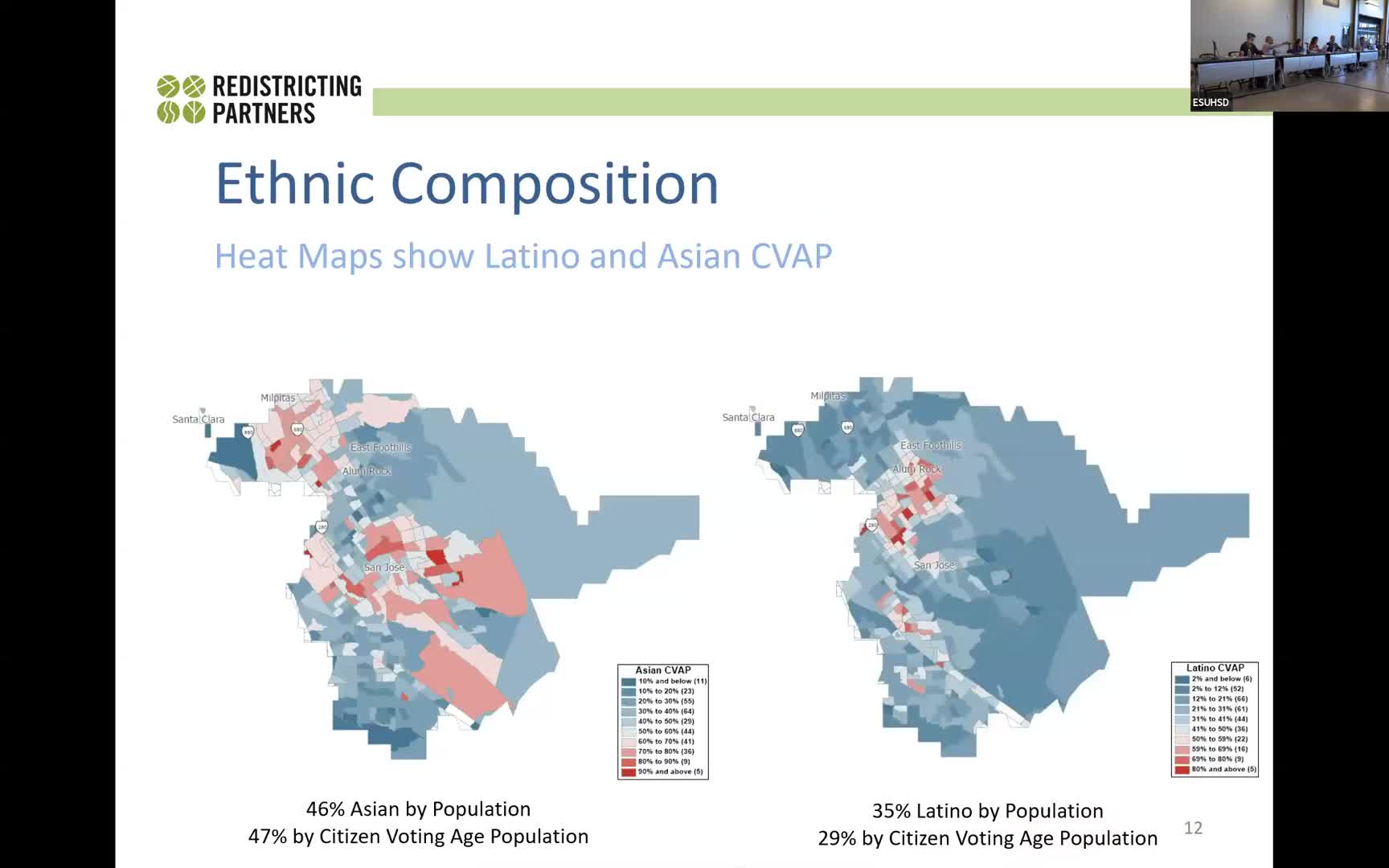San Jose analyzes ethnic demographics for new district mapping strategy
June 27, 2025 | East Side Union High, School Districts, California
This article was created by AI summarizing key points discussed. AI makes mistakes, so for full details and context, please refer to the video of the full meeting. Please report any errors so we can fix them. Report an error »

The East Side Union High School District (ESUHSD) held a Special Board Meeting on June 26, 2025, to discuss critical demographic data and its implications for district redistricting. The meeting focused on the ethnic composition of the district, particularly the Latino and Asian communities, and how this data will influence the drawing of electoral districts.
The meeting began with a presentation on the ethnic demographics within the district. It was noted that the Latino community is predominantly located in the central and southeastern areas, while the Asian population is concentrated in the northern and central southern parts. The presenter highlighted that 60% of the Asian population is Vietnamese, followed by 15% Filipino and 14% Chinese, emphasizing the diversity within the Asian demographic.
A significant point of discussion was the difference between total population figures and the citizen voting age population (CVAP). The presenter explained that while the Latino population constitutes 35% of the total district population, this figure drops to 29% when considering only eligible voters. In contrast, the Asian population remains relatively stable, increasing from 46% to 47% when transitioning from total population to CVAP. This disparity raises concerns about the voting power of the Latino community, as a substantial portion of the population consists of non-citizens or children.
The board members engaged in a detailed discussion about the implications of these demographic shifts for redistricting. They acknowledged the necessity of drawing districts that accurately reflect the eligible voting population to ensure fair representation. The presenter reiterated that federal law mandates the use of CVAP for redistricting, as it provides a more accurate picture of the electorate's potential influence in elections.
The meeting also touched on the historical context of redistricting practices, particularly in relation to minority communities. The board discussed past legal challenges and the importance of creating districts that do not dilute the voting power of any minority group. This is particularly relevant for the Latino community, which has faced challenges in maintaining effective representation due to lower voter turnout rates.
In conclusion, the ESUHSD Special Board Meeting highlighted the complexities of redistricting in a diverse community. The discussions underscored the importance of using accurate demographic data to ensure that all communities are fairly represented in the electoral process. The board plans to continue evaluating these factors as they move forward with the redistricting process, aiming to create districts that reflect the true voting power of the district's residents.
The meeting began with a presentation on the ethnic demographics within the district. It was noted that the Latino community is predominantly located in the central and southeastern areas, while the Asian population is concentrated in the northern and central southern parts. The presenter highlighted that 60% of the Asian population is Vietnamese, followed by 15% Filipino and 14% Chinese, emphasizing the diversity within the Asian demographic.
A significant point of discussion was the difference between total population figures and the citizen voting age population (CVAP). The presenter explained that while the Latino population constitutes 35% of the total district population, this figure drops to 29% when considering only eligible voters. In contrast, the Asian population remains relatively stable, increasing from 46% to 47% when transitioning from total population to CVAP. This disparity raises concerns about the voting power of the Latino community, as a substantial portion of the population consists of non-citizens or children.
The board members engaged in a detailed discussion about the implications of these demographic shifts for redistricting. They acknowledged the necessity of drawing districts that accurately reflect the eligible voting population to ensure fair representation. The presenter reiterated that federal law mandates the use of CVAP for redistricting, as it provides a more accurate picture of the electorate's potential influence in elections.
The meeting also touched on the historical context of redistricting practices, particularly in relation to minority communities. The board discussed past legal challenges and the importance of creating districts that do not dilute the voting power of any minority group. This is particularly relevant for the Latino community, which has faced challenges in maintaining effective representation due to lower voter turnout rates.
In conclusion, the ESUHSD Special Board Meeting highlighted the complexities of redistricting in a diverse community. The discussions underscored the importance of using accurate demographic data to ensure that all communities are fairly represented in the electoral process. The board plans to continue evaluating these factors as they move forward with the redistricting process, aiming to create districts that reflect the true voting power of the district's residents.
View full meeting
This article is based on a recent meeting—watch the full video and explore the complete transcript for deeper insights into the discussion.
View full meeting
